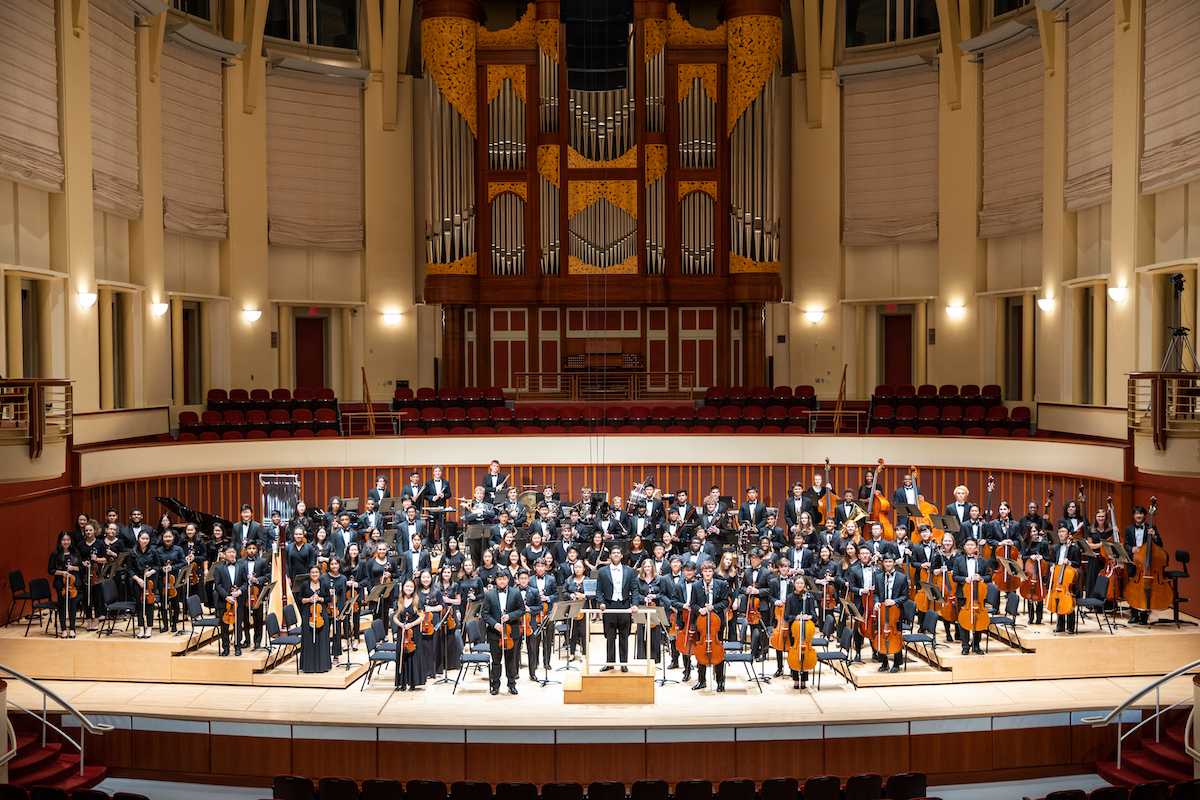Catherine MacGregor remembers the moment she fell in love with orchestral performance.
She was a high school sophomore violinist rehearsing Edward Elgar’s “Enigma Variations” in 2012 with the Emory Youth Symphony Orchestra (EYSO). It was her first time inside Emerson Concert Hall at Emory’s Schwartz Center for the Performing Arts. It was also her first time playing with a full-sized orchestra.
“And I was just so nervous,” she says. “But we were playing the ‘Nimrod’ movement, which is slow and lyrical and really moving. And I was having an out-of-body moment, getting to be in such a beautiful space, playing this beautiful music.”
Today, MacGregor leads a life immersed in symphonic music as interim executive director of the DeKalb Symphony Orchestra and music history instructor at Kennesaw State University. And she traces that career back to this moment as a young violinist with the EYSO.
“I just recall stepping onto that stage,” she says, “and, for the first time, having this sense of, ‘I’m not just in my practice room by myself or playing for a teacher or playing at a recital,’ but, instead, playing with so many other people. It really changed the kind of impact I saw music could have: the idea that we’re all in it together, creating one out of many.”
Rare performance opportunities
Since its founding in 2005, the EYSO has attracted top high school musicians from across north Georgia, some of whom travel hours to attend weekly rehearsals. The group has performed with guest soloists from the Atlanta and San Francisco symphony orchestras, as well as the Vega Quartet, Emory’s string quartet in residence. The group has also traveled to perform at New York’s Lincoln Center for the Performing Arts, among other places. Members have gone on to study at top music conservatories and at nationally ranked colleges and universities.
But it’s experiences like MacGregor’s first rehearsal that most inspire EYSO director Paul Bhasin. Bhasin is the Donna and Marvin Schwartz Professor of Practice in Music. He also directs undergraduate research and orchestral studies with the Department of Music and conducts the Emory University Symphony Orchestra (EUSO).
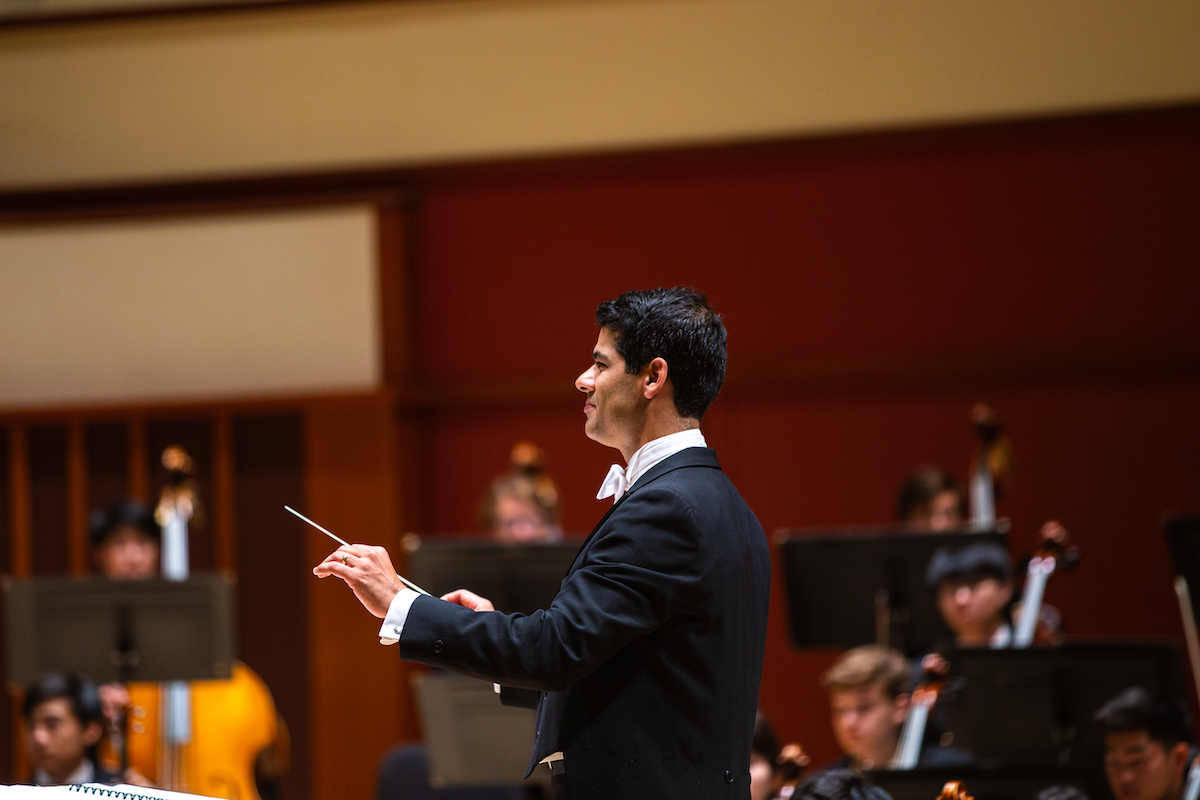
“I always tell them, ‘The person sitting next to you is not your competitor, they’re your colleague,’” says director Paul Bhasin. “‘So, earn trust and give trust, because these experiences will help shape your path.’”
Like MacGregor, Bhasin fell in love with performing classical music as a high school student in a youth symphony. “And I am happy that our organization can help students have positive early experiences,” he says.
On Wednesday, Feb. 26, the EYSO celebrates its 20th anniversary with a concert at the Schwartz Center’s Emerson Hall. The celebration will feature soloists from Atlanta’s Merian Ensemble in a world premiere of “Metamorphosis,” a piece by composer Elizabeth Younan. The Emory University Chorus will join the ensemble for a performance of Haydn’s “Te Deum.” EYSO alumni will accompany the performers for Bizet’s “L’Arlésienne” Suite No. 2.
It’s an exciting moment of intergenerational community for an ensemble that, for two decades, has brought together North Georgia’s top young musicians to play major orchestral works. That’s rare at the high school level.
By giving young musicians the chance to learn and perform major works by Beethoven, Stravinsky and Sibelius in their entirety, as well as more contemporary pieces, Bhasin says the EYSO acts as an active partner with students’ high school ensembles.
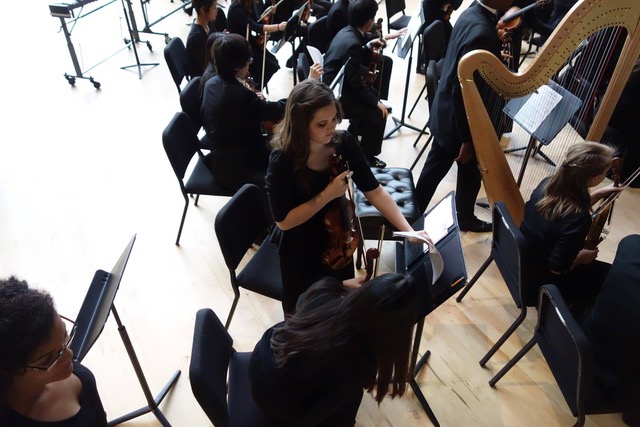
Catherine MacGregor onstage during an EYSO trip to Lincoln Center in New York City in 2014
And, he says, it offers a critical contrast to today’s screen-dominated ways of learning.
“By contrast, what we ask them to do is to come up with an original idea, support it with evidence from the score and from social, historical and theoretical sources, and then test that hypothesis on stage,” he says. “That is a mode of expression that I think these young people crave, and it offers important balance to their existence.”
Once a musician, always a musician
The ensemble also offers college-preparatory counseling to help students determine their best next steps after high school, whether that’s an arts conservatory like the Juilliard School or a liberal arts college.
Katie Shin’s time in the EYSO made her choice clear. A violinist who played with the ensemble from 2017-21, Shin hoped to pursue an education in neuroscience, but she didn’t want to give up playing in a serious music ensemble.
In the end, she chose Emory, where she could perform with the EUSO while following her STEM ambitions. Shin earned a merit scholarship in music and academics — which she credits to her time with EYSO.
It helped, too, that her time with the youth ensemble caused her to fall in love with the campus.
“I like to say this is my eighth year at Emory,” jokes the senior, who volunteers as a tour guide for prospective students.
A double major in neuroscience and behavioral biology and violin performance, Shin plans to pursue a PhD in public health. But, she adds, “once you’re a musician, you’re always a musician.” She looks forward to playing with community ensembles once she graduates.
Crudity before mastery
A future as an Emory Eagle was also in the cards for EYSO alumnus Nick Wandrick, a clarinetist.
The sophomore neuroscience and behavioral biology major is considering a future as a professional musician but, whatever his path, he says music performance will always have a place in his life. He says the sheer joy he experienced onstage with the EYSO sparked that.
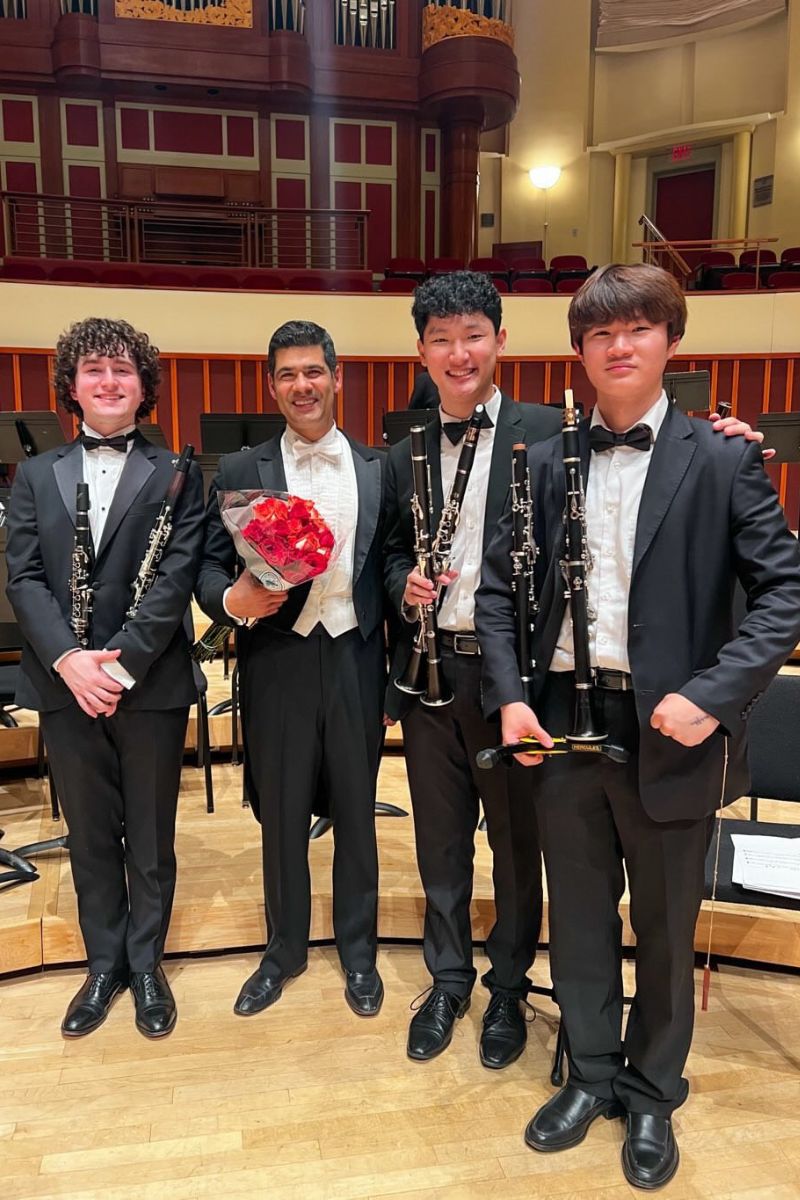
Nick Wandrick, director Paul Bhasin, Kevin Jin and Kyunghwan Lim in New York City
His time in the youth ensemble tested Wandrick’s mettle as well.
A performance of “The Red Pony Suite” by Aaron Copland required him to switch among three clarinets tuned to different keys.
“And there are different tendencies with all these instruments,” he says, “and different things you need to keep in mind with this piece; it really was one of the toughest pieces I’ve ever played.”
But that wasn’t all. During the concert’s second half, the principal clarinet player became lightheaded during Tchaikovsky’s Symphony No. 4, requiring Wandrick to step in and play the part.
Looking back, Wandrick, who today plays with the EUSO and the Emory Wind Ensemble, laughs. There’s no way he’d want to repeat that night again. “But at the same time,” he says, “it added to my belief that I can handle things like that. So, in a strange way, I’m thankful for that concert.”
Moments like these are a critical part of the EYSO experience.
“I tell students that at some point, you have to put your new skills to the test,” says Bhasin, “and that means there will be some crudity before mastery, and if, as a student, you don't embrace crudity in public, then you aren’t actually growing.”
It’s a lesson he wishes someone had taught him earlier, as a high school trumpeter who struggled with stage fright — which he says stemmed from a sense of perfectionism.
EYSO students have plenty of opportunities to put their skills to the test before critical auditions for summer and college ensembles. The ensemble hosts mock auditions with feedback from professional musicians. Members may also workshop pieces they’ve composed and compete to have them performed by the group, and audition to play a solo in the season’s final performance.
Colleagues, not competitors
Amid these opportunities to assert their ambition, Bhasin says he works to create a supportive environment, starting with the students’ first rehearsal each year. “I always tell them: ‘The person sitting next to you is not your competitor, they’re your colleague.’”
He tells them about his own youth symphony compatriots who remain important contacts to this day. “So, earn trust and give trust,” he advises students, “because these experiences will help shape your path.”
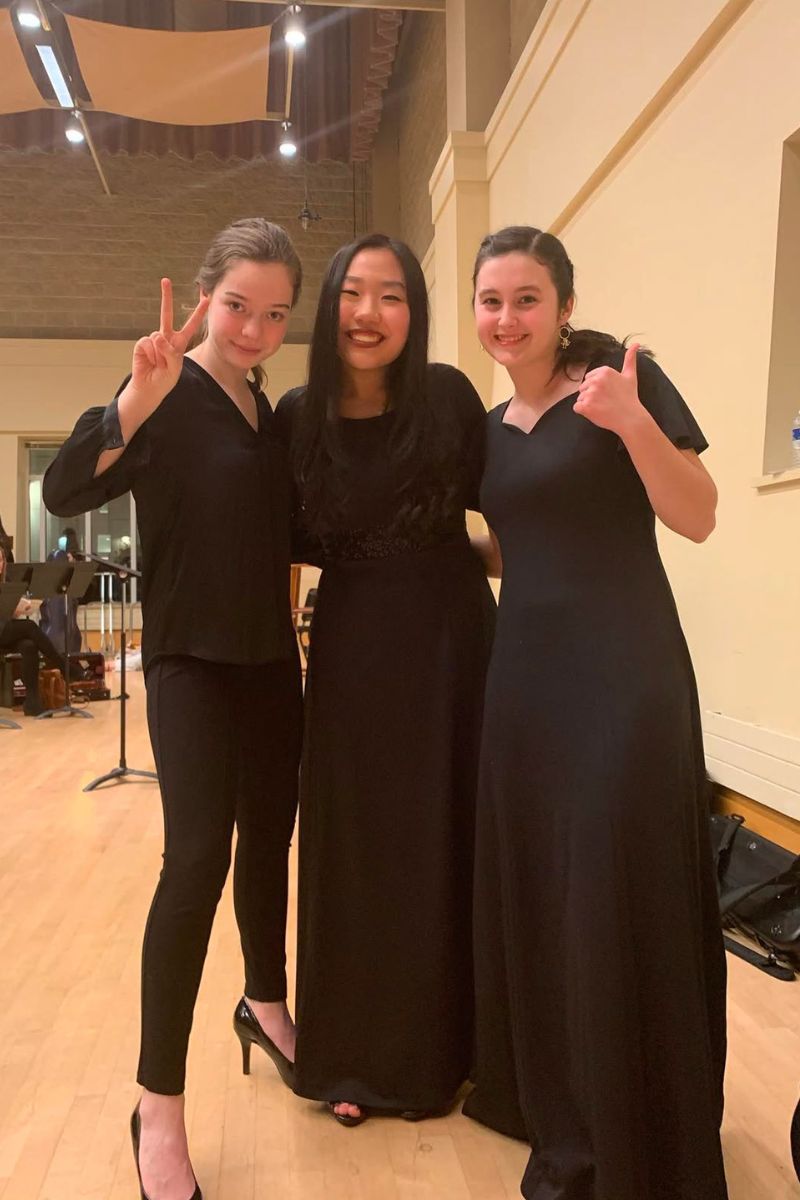
Claudia Dorian, Katie Shin and Emma Mason performed at Lincoln Center in New York City with the EYSO.
That collegiality, Shin says, is part of Emory’s larger culture of “being a safe space in which you’re able to make friends and be supported,” no matter what work you’re engaged in.
This semester, it’s all coming full circle for Shin, who’s looking forward to playing Shostakovich’s Symphony No. 9 in one of her final performances with the EUSO before she goes on to pursue her PhD.
It’s a piece she first played as a high schooler in the EYSO, back when she was still learning the nuances of being a good music stand partner and playing with a large ensemble.
These days, in her music department work-study role as orchestral manager of the university symphony, she finds herself mentoring the next generation.
“A couple of girls came up to me last Wednesday while I was helping with the [EYSO] rehearsals,” she says, “and they’re like, ‘Oh, I heard you’re part of the university orchestra. Can I get your email?’ And I’m like, ‘Of course!’”
Bhasin credits the university environment for his ability to nourish this supportive ecosystem.
“Emory is making this commitment to supporting something that is uniquely beneficial for these young people,” he says, “and I feel like that’s something I’m very proud of.”
His favorite moments, though, are when the lights go down and a performance begins.
“It’s kind of a crucible for democracy itself, really,” he says. “It’s, ‘Let's arrive at something original together and let's present it, under pressure, in front of people, on stage. And let's do all that without talking.’ If you can do that, then you are set up to engage with one another in a healthy society.”

